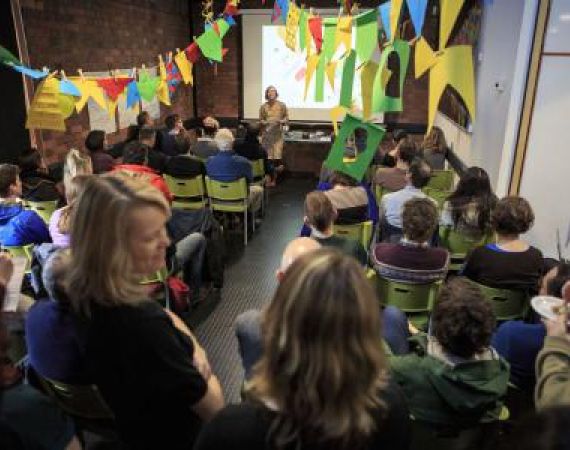Posted on Thu 23 Jan 2014
Recife: The Playable City Lunchtime Talk Write-up
At last week’s Lunchtime Talk slot, we were treated to a showcase of the ideas emerging from the first part of Recife: The Playable City, which took place in the Studio over the preceding fortnight. The project is being run in collaboration with Brazilian Technology Park, Porto Digital and the…

Victoria Introducing the talk: Photography © Max McClure
At last week’s Lunchtime Talk slot, we were treated to a showcase of the ideas emerging from the first part of Recife: The Playable City, which took place in the Studio over the preceding fortnight. The project is being run in collaboration with Brazilian Technology Park, Porto Digital and the British Council, and brings together 20 creatives, technologists and producers from both the UK and the Pernambuco region of Brazil, to create new ideas surrounding the theme of the ‘Playable City’. The participants are working in small teams to come up with creative initiatives, which rethink public spaces in order to playfully connect inhabitants. Part two of the workshop will take place in Recife, Brazil, where some of the ideas formed in Bristol will be further developed. The showcase was a way of culminating all the ideas formed into a hands-on presentation for the public. Read on to find out more...
Vic, our producer on the project, introduced the talk, and gave us an insight into the project. Having transformed Bristol into the world’s first ‘Playable City’ after last year’s Playable City Award, the project aims to turn Recife into the world’s second. Recife: The Playable City focuses on cross-cultural initiatives, which aspire to create a city that can be re-written by its inhabitants, in order to create an open, enjoyable and serendipitous environment to live in.
Tine, Germana, David, Mabuse and Isabelle were the first team to speak to us about their ideas. The team hatched a plan to take advantage the rivers in the City, using them to connect the public by encouraging people to travel together by boat. They came up with the idea to create a visible icon for the city by introducing boats flanked with interactive lights that respond to ‘interactive hotspots’ along the route of the river, and also to data, such as readings of temperature or pollution. This initiative will help to reduce traffic and pollution in the city and will also supply a relaxing and fun way for inhabitants to travel and connect with each other.
Leo, Phil, Rosie, Katherine and Daniel were next to speak. Their projects explore the ways in which people interact with their city, both on a personal level, and as part of a crowd. Their first project, Key to the City, focuses on solo experiences. The project involves installing a series of free-standing doorways in public areas. When someone walks through a doorway, it triggers content, like a sound or projection, which tells the story of the city. They made a prototype for Bristol called ‘The Doorway to Self-Esteem’, that gave a round of applause to anyone who stepped through it. The second project, Murmeration, focuses on group dynamics, and aims to mimic the characteristics of a flock of starlings, by furnishing individuals in a crowd of thousands with their own infra red lights. The lights would interact with each other, and change colour, causing people to sort themselves into groups or move around each other in a way that can be observed from above as a playful study of group leaning and decision making.
George, Camila, Andrew, Eduardo and Fábio followed, and told us of their ideas to re-animate a particular place in Recife called Tiradentes, which sits in between office blocks and a Favela, but rarely sees inhabitants of these two places interacting with each other. By restricting themselves to this to this specific place, they felt able to deeply explore the Square as a context. Their ideas involve introducing interactive elements to the area. One idea involves a bus stop where, while waiting, you can help to construct a story with other people who have waited there by texting a character, place or consequence, and receiving a text when the story is finished. Another idea involves incentivising people to walk through the park by adorning it with interactive lights, creating an atmosphere of enchantment.
Laura, Natasha, Filipe, Helder and Thaís wound up with a brief chat about their projects, which explore how small objects can make a big impact on the way in which we interact with our cities and with each other. They have conceived of an interactive ‘telescope to a beautiful city’, which plays content as soon as you pick it up and records what you see. They also dreamt up and prototyped the ‘Sonic Branch’; a tree with touch pads on it, which requires more than one person to touch the tree and each others’ hands in order to complete a circuit, and play music. Different touchpads correspond to different layers of the music, so you are effectively DJing with a tree!
After these introductions, everyone at the showcase was invited to walk round the Studio to play with the prototypes, watch simulations and talk to the participants. The atmosphere was electric as people were excitedly imagining what Recife would be like if these projects were realised. The second part of the workshop will take place in Recife in April, and we are very excited to see the furthering of these ideas. Read more about the project on the Recife: The Playable City website.